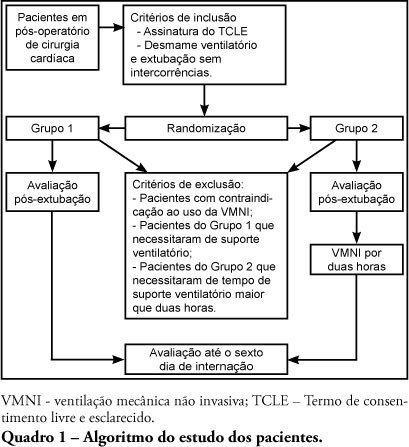You searched for:"João Batista Raposo Mazullo Filho"
We found (2) results for your search.-
Noninvasive mechanical ventilation in immediate postoperative cardiac surgery patients
Rev Bras Ter Intensiva. 2010;22(4):363-368
Abstract
Noninvasive mechanical ventilation in immediate postoperative cardiac surgery patients
Rev Bras Ter Intensiva. 2010;22(4):363-368
DOI 10.1590/S0103-507X2010000400009
Views0See moreBACKGROUND: : Noninvasive ventilation is routine in acute respiratory failure patients; nevertheless, the literature is controversial for its use in cardiac surgery postoperative period. OBJECTIVE: To evaluate the effectiveness of preventive noninvasive ventilation in the immediate postoperative period of cardiac surgery, monitoring its impact until the sixth day of hospitalization. METHODS: This was a controlled study, where patients in immediate postoperative period of cardiac surgery were randomized into two groups: control (G1) and investigational (G2) which received noninvasive ventilation set on pressure support mode and positive end expiratory pressure, for 2 hours following extubation. Were evaluated ventilatory, hemodynamical and oxygenation variables both immediately after extubation and after noninvasive ventilation in G2. RESULTS: Thirty-two patients completed the study, 18 in G1 and 14 in G2. The mean age was 61±16.23 years for G1 and for G2 61.5 ± 9.4 years. Of the initial twenty-seven patients in G1, nine patients (33.3%) were excluded due to invasive ventilation requirements, and three patients (11.11%) had to go back to invasive mechanical ventilation. None of the 14 G2 patients was reintubated. Patients undergoing early ventilatory support showed better results in the assessments throughout the hospitalization time. CONCLUSION: Noninvasive post-cardiac surgery ventilation was proven effective, as demonstrated by increased vital capacity, decreased respiratory rate, prevention of post-extubation acute respiratory failure and reduced reintubation rates.

Search
Search in:
KEY WORDS
Case reports Child Coronavirus infections COVID-19 Critical care Critical illness Extracorporeal membrane oxygenation Infant, newborn Intensive care Intensive care units Intensive care units, pediatric mechanical ventilation Mortality Physical therapy modalities Prognosis Respiration, artificial Respiratory insufficiency risk factors SARS-CoV-2 Sepsis





